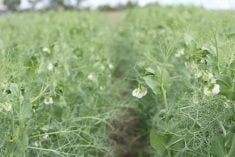WINNIPEG (Reuters) – Canadian hog farmers have reduced the country’s herd to its smallest size in at least five years, but more dramatic reductions may lie ahead once hard-hit farmers receive government downsizing incentives.
The hog inventory fell 7.3 percent between the third quarter of 2008 and the third quarter of 2009, Statistics Canada said.
The breeding herd dropped by 4.5 percent over the same period.
Producers have suffered for several years from a crushing combination of low prices, high feed costs and a volatile Canadian dollar.
Read Also

Prairies have variable soil moisture conditions
The dry weather in the west was welcome for preserving grain quality and advancing harvest, but it has resulted in very dry soil moisture conditions.
Discovery of the H1N1 flu in an Alberta pig herd in April resulted in more than a dozen countries banning Canadian pork, although most have since restored imports.
Canada is one of the world’s leading pork exporters.
“I don’t think we’re nearly as far down the downsizing road as we’re going to get,” said Sask Pork general manager Neil Ketilson.
“We’ve had some relief on feed costs, but the price of hogs is terrible.”
Continued decline
Farmers had 11.8 million hogs on their farms Oct. 1, down from 12.7 million on the same date last year. The hog herd had been dropping by 6.7 percent when Statistics Canada last measured supplies July 1.
Most damaging has been the U.S. country-of-origin labelling law that has resulted in American meat packers and feeders reducing imports of Canadian hogs and cattle to avoid costs of segregating foreign from domestic supplies.
Hog farmers exported 1.6 million hogs during the third quarter, with year to date exports of five million head, down 31.5 percent from the same period in 2008. The U.S. is by far Canada’s largest export market for livestock.
Money from a $75 million fund that the Canadian government earmarked on Aug. 15 to encourage hog farmers to close their barns for at least three years has not yet reached farmers.
Farmers are required to bid the amount of money they would accept to idle their barns.
The first wave of bids was expected to open Nov. 4.
Interest in the funds to cease production is running high, Ketilson said.
The inventory of farrowed sows and pigs kept for breeding have also fallen to at least five-year lows, Statistics Canada said, which suggests the overall herd downsizing trend will continue.
Maple Leaf Foods and Olymel, the two biggest hog processors in Canada, should see ample supplies in the short term as farmers slaughter their hogs and face reduced access to the United States, Ketilson said. Domestic slaughter is up 5.9 percent in the third quarter, likely reflecting increased production by Olymel.
In the longer term, supply could become a bigger concern for packers, which have lost money on hog processing of late, Ketilson said.














